Index:
- Cannabis Basics
- Marijuana
- Effects of Cannabis
- Using Cannabis
- What Gets You High
- Why Grow Indoors
- Why Grow Outdoors
- Hydroponics vs Soil
- Sativa vs Indica
- Choosing Your Variety
- Potency
- Yields
- Flowering
- Seeds
Related Posts
- Diy Grow Fridge Tutorial
- The Art Of Potsai, An illustrated guide to growing miniature marijuana plants
Don't forget to bookmark this page you might need to come back later :-)
Before we begin It is important for me to express the fact that I use marijuana medically and recreationally , However it is unfortunately illegal were I live and we are currently fighting legalization. When it comes to cannabis my passion only allows me to grow 100% organic medicine. It is probably worth mentioning I am not a writer, I simply aspire to write because steemit makes sharing my knowledge rewarding as well as worth my while. The information consisting of Marijane's Diary is the result of my own personal grow experiences and the use of online resources in public domains.
Marijane's Diary is intended as the first of ten posts I will be covering over the next few weeks. I plan on creating a complete reference and knowledge base about growing cannabis from start to finish as a online resource for Medical use as well as for educational purposes. You can follow me: @bitminter.
Please Note: The use of cannabis is illegal in some country's, please consult with a legal professional if you are uncertain of the laws and regulations of cannabis in your country.
Growing Cannabis
Growing your own medical cannabis can be exciting and very rewarding! Homegrown cannabis is ideal for the Medical Grower. Now let's ditch the dealers with ridiculous top- shelf prices and learn to grow your own Medical grade bud. All steemit Cannabis growers can grow their own unlimited supply of A-Grade ganja practically for free. From now on Ditch the dealer and grow your own Medical grade Cannabis in the comfort of your own home!
Whether you are planning on-cultivated indoor or outdoor, with hydroponics or with soil, in order for your cannabis to grow well we need to consider at least six essential elements:
- 1 Light . (Must be the correct spectrum, light intensity, and light period).
- 2 Water. (Must be adequate but NOT in excessive).
- 3 Air. (Always consider temperature, Air flow, and CO2).
- 4 Nutrients. (Must contain the correct ratio).
- 5 A Growing Medium. (Has to have the right texture, ingredients and consistency
- 6 Optimal environmental conditions. (heat, humidity, etc...).
Growing cannabis today is exploding exponentially in popularity with the recent rise of regulation and legalization in some country's. Many authorities are referring to this sudden spike of interest as the “green rush”. A rising wave of green that's sweeping the globe and industries by storm.
A benefit of growing your own cannabis in the security of your own home is that most of the stuff out there that is commercially grown cannabis is grown based on a couple factors, the buds overall look and smell, and the plant's ability to yield well. Often the quality of the high is entirely neglected as it tends not to be a good selling point. The highs you can experience when growing your own plants is phenomenal in comparison!
Many agree the best reason for anyone wanting to growing your own is sanctification you will get out of watching your seeds become lush plants, and lets not mention the incredible buds you will produce, Hopefully for a lifetime's supply of delicious pot to enjoy.
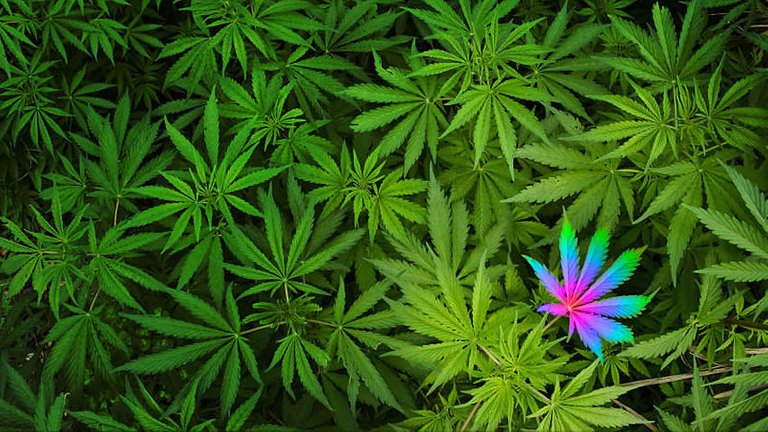
Marijuana, Also known as the Indian hemp plant, Cannabis Sativa (cannabis), is a drug composed of leaf and flowers or buds. It is normally dried and crushed and used pipes or rolled into cigarettes(“joints” or “blunts”) for toking. The plant, also known by a variety of names, including pot, turbo cabbage, grass, bud, and weed, can also be mixed into foods and beverages. Cannabis varies in potency, depending on many different factors from where and how it is grown, prepared for use, or stored and cured.
It's a Fact that Cannabis is the only plant that produces the chemicals known as cannabinoids. These cannabinoids are Psychoactive and are responsible for the various effects Cannabis can have. Not all, but many cannabinoids get you high to some extent .
The most important cannabinoid and know active ingredient in cannabis is tetrahydrocannabinol (THC),and is present in all parts of both the male and female plants. However the most concentrated amounts of(cannabin) can be found in the flowering tops of the female. Hashish, a more powerful form of the plants features , is made by collecting and drying the plant's resin. Hashish is about eight times as strong as the cannabis typically smoked in the the world today.The dried cannibis flower tops (buds) are the most potent and can contain up to 25% THC.
Chinese herbal documents dating back from 2700 BC prove Cannabis to be long considered valuable as an analgesic, an anesthetic, an antidepressant, an antibiotic, and a sedative. Although it was traditionally usually used externally (e.g., as a balm or smoked), people in the 19th century sometimes administered internally to treat gonorrhea and angina pectoris for example.

The effect that cannabis has on a specific user depends on the strength and strain, how often it's smoked, how recently it was smoked and how a individuals body naturally reacts to the cannabis properties.
Positive Effects of cannabis:
The most common include mood lifting, Relaxation, stress reduction, calming and Creativity, philosophical or deep thinking...ideas will tend to flow more easily and be more creative when under the influence, Increased appreciation of music, Increased awareness of senses(tasting, feeling, smell). Change in experience of muscle fatigue. Pleasant body feel. Increase in body/mind connection Pain relief(headaches, cramps, and various others) Reduced nausea(also used medically for this purpose) Much more....
Neutral Effects of cannabis:
Increased appetite and thirst; “munchies” General change and shift in consciousness(as with many psychoactives). Sleepiness Blood shot red eyes(more common with certain varieties of cannabis and inexperienced users) Mouth dryness aka “Cotton mouth” Temporarily interrupts linear memory Difficulty following a train of thought, can be slightly A.D.D. Cheek, jaw, facial tension(less commonly reported)
Negative Effects of cannabis:
Unfortunately Nausea, Coughing, asthma, upper respiratory problems, Difficulty with short-term memory during effects and during periods of heavy frequent use Slowness and delayed reactions, especially dangerous when driving or operating machinery Racing heart, agitation, and tenseness Mild to severe anxiety Panic attacks at very high doses(usually oral) or in sensitive users Headaches Dizziness, confusion, vomiting Possible psychological dependence development on cannabis "Mild" withdrawal symptoms occur after daily use in some users. These may last for 1-6 weeks after cessation of use and can include anxiety, anhedonia (reduced experience of pleasure), headaches, general unease/discomfort, difficulty sleeping, and a strong desire to smoke pot.

Smoking/Inhaling: Burning or vaporizing cannabis and inhaling the smoke into the lungs is the fastest route to the blood stream. Conventional wisdom is that holding in the smoke increases the effects felt. Recent research shows the opposite; it causes more harm to the lungs without increasing the amount of THC absorbed. Studies done in Australia indicate that 95% of the THC in cannabis is absorbed in the first few seconds of inhaling. Holding in the smoke longer just allows more tar and other noxious chemicals to be absorbed.
Take small, shallow puffs rather than deep inhalations. Irritation of the throat and lungs is one of the most obvious adverse effects to the cannabis smoker as is the inevitable cough upon inhaling. The cough is the body's reaction to the irritation of the numerous constituents of the smoke. Prolonged and repeated exposure to these irritants can lower resistance to, and aggravate infections from viruses, bacteria, or fungi.
The lesser coughing, the safer the smoke. The fewer puff s the better; the more potent the cannabis used is the fewer puff s required. For these reasons, it is preferable to use only the more potent flower tops, or high grade hash for smoking use. Despite the obvious dangers of inhaling hot smoke, there is evidence that in some cases (ie. asthma) smoking could be a beneficial medical use of cannabis. Another advantage of smoking is that it allows the user to control their dosage better as the effects are almost immediate, unlike when eating, or using THC in pill or spray form.
In general however, smoking is not the best way to take cannabis, especially for pain, being a less efficient use of the herb than eating. However, many medical users find they appreciate the immediate and pleasurable effects of smoking cannabis and the harm of smoking can be reduced in various ways. One alternative to inhaling smoke is to release the THC through Vaporization; inhaling vapor rather than smoke, see vaporization.
Pipes and Bongs: Many ingeniously designed products are on the market that claim to offer a cooler smoke but they are not all safe or efficient to use. Avoid wood, aluminum or plastic materials. Use glass, stainless steel or brass pipes and bongs.
Joints: Smoking cannabis in ‘joints’ is one of the least harmful ways of smoking. A loose, fat joint is preferable to a thin one because the temperature of the smoke is lower in a thick joint.
Mixing cannabis with tobacco counteracts the positive effects of THC. Some research suggests that Cannabis may actually off set some of the harmful effects of tobacco but there is also evidence that the relaxing effects of cannabis on the lungs allows the toxins in tobacco to get in deeper.
There is evidence that a thin joint gives a more stimulating ‘high’, while a fat joint has a more sedative effect(due to different burn temp in ‘fat’ or ‘thin’ joints). Avoid rolling papers with 'strawberry' tasting chemicals and the like, 'rainbows' and any use of colored inks.
Water Pipes: Recent research suggests that water pipes are the most harmful and least efficient methods of smoking cannabis. The water absorbs a great deal of the THC in the smoke(up to 50%!), increasing the amount of tar the smoker must ingest to get the desired result. Using a water pipe with a mouthpiece less than 20cm from the water level can allow water vapor and water drops to enter the lungs.
Vaporization: Using a vaporizer which heats but does not burn the cannabis, is an alternative to smoking. The process involves releasing the THC as vapor which is inhaled rather than smoke. The effect is ‘clearer’ and it is far more economical and reduces the exposure of the throat and lungs to products of burning. Vaporization work well because THC, the active ingredient of cannabis, is a resin that vaporizes at a lower combustion(burning) point than cellulose.
You can make your own vaporizer very cheaply or buy various types starting at around £35 up to £300+ for the 'hospital standard' 'Volcano’. High heat destroys some of the THC in smoked cannabis(estimates vary). Vaporizers heat it more gently; the THC molecules decarboxylate and evaporate in a whitish vapor. A problem with vaporizers is with correct use. Many users tend to overheat and consequently burn the stuff. They are now 'smoking' not 'vaporizing' the cannabis, often without realizing - and just as many toxic tars are released as smoking in a pipe.
Vaporizers sometimes fail to satisfy longtime smokers who associate burning lungs with getting high. They distrust the incredibly smooth taste of the vapors, and they don't like waiting 30 seconds to 1 minute for each hit. However they always like the fact that their supply seems to last up to four times as long because vaporization wastes so little of the active ingredients lost through burning it. Some regular users of vaporizers have complained that they produce a fine dust along with the vapor. This can't be good and they should maybe be fitted with a filter system but vaporizers are still the safest way to consume cannabis using heat.
Eating or Drinking: Simply sucking a small piece of hashish or eating cannabis prepared as a cake, drink or other food is a very effective and economical method of using cannabis. The effects take up to an hour and last 4-12 hours. Over dose is possible by eating too much. This could result in an unpleasant ‘whirlingpit’ feeling but no lasting physical damage. If in doubt slowly sample the dose; experiment with a little, and then a little more. More worrying are the dangers of adulteration and infection encouraged by the unregulated trade in cannabis.
These include smuggling methods and profiteering practices which can make eating the resulting product totally undesirable. In general avoid eating most hash especially ‘Soap Bar’ and ‘Manali’ or 'Squiggie' black. Eating Hemp seeds or their oil(which have no THC content) is a very valuable source of nutrition; a quality which can have considerable medical value and contribute to general well being.
Tinctures: The active ingredients of the plant are extracted as oil and can then be used either as drops taken orally, or the ingredient for creams and lotions to be rubbed on the skin to relieve pain and other symptoms.
Creams and Lotions: Applied on the skin to treat complaints ranging from muscle pain and/or tremors to ache. You can make these your self. The simplest way to do this is to put leaves and buds of cannabis into a bottle filled with surgical alcohol available in any chemist. Leave in a dark place for 1-3 weeks, shaking every day or as often as possible, then use to rub on area suffering from pain.
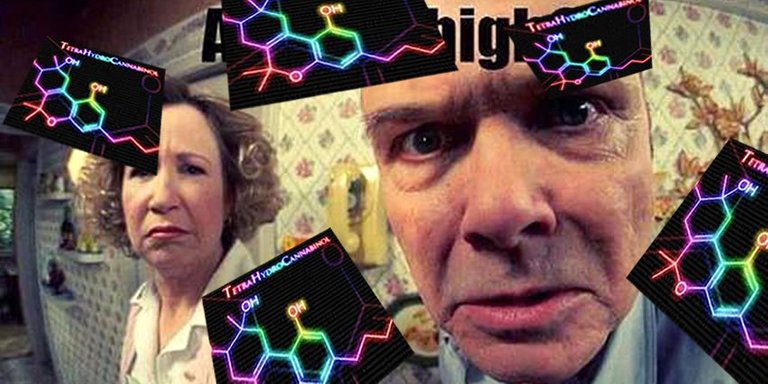
The main factors in determining the quality and intensity of the high are the amount, and the ratio of cannabinoids present in your bud. Cannabinoids are what are responsible for getting that sensational soaring high out of your buds. Currently there are more than 40 known cannabinoids, but most of these occur in very tiny amounts and aren't important to the quality of the high. The cannabinoids that are found in the greatest quantity and have the most influence on your bud's high are THC, CBN THCV, and CBC.
THC(tetrahydrocannabinol) is the main psychoactive ingredient In marijuana. It accounts for most of the high. THC occurs in all varieties of cannabis. CBD(cannabidiol) occurs in almost all cannabis varieties in quantities that range from trace amounts to 95 percent of all cannabinoids present.
In its pure form CBD is not psychoactive, but it does have sedative, antibiotic, and analgesic qualities. CBD contributes to the high by interacting with THC to potentiate or antagonize certain qualities of the high. In general, it potentiates the depressant effects and antagonizes the euphoric effects.
CBD is also known for delaying the onset of the high, but makes it last much longer. So THC-CBD ratios are very important when considering the effects of your high. Keep in mind that the ratios of cannabinoids found in different varieties of cannabis plants also tend to vary greatly.
THC (Tetrahydrocannabinol)
THC is the active psychoactive ingredient in marijuana that gets a user high. Without it, or in extremely low amounts – you don't get high. All plant's THC levels vary greatly. Some plants can have THC levels of 100%, yet the quantity of the THC isn't high so it's less potent. On the other hand, some plants may only have 50% THC, but the levels will be very high. A good potent plant will have both high levels and quantities of THC.
The key difference between THC levels and THC quantities is that THC levels are genetically predetermined. This means that they are not under the influence of the grower. THC quantities though are in fact controllable by the grower. When growing weed, the THC quantities are basically bud mass and how much resin can be generated.
To determine how potent a plant is when examining strains check for the THC levels to determine the potential potency of the plant. Nowadays many seed-banks clearly accurately state their strains' legitimate THC levels, but there are also a lot of shady seed dealers out there too who over-exaggerate their THC levels(read on to find out about some recommended reputable suppliers).
CBD (Cannabidiol)
CBD is what amplifies certain effects of THC and depresses others. CBD is an isomer of THC, which means they share the same molecular formula, but have different structural formulas. Basically they are made up of the exact same molecules, except that the molecules are connected in different orders.
CBD by itself has no psychoactive properties(CBD by itself does not get you high), however it does regulate the euphoric effect of THC and gives it more of a sedative effect(more of a "chill" high). Cannabis often has a high CBD content (as much or more than 40% CBD in most Cannabis extracts).
High THC and low CBD produce a strong clear headed, more energetic high. Low THC and high CBD produces a stoned lethargic feeling, a heavy sluggish tired body and a dull feeling mind. High levels of both THC and CBD produces a strong, almost dreamlike high.
To sum things up, if you want a more energetic high, you want more THC and less CBD. Usually Sativa and Sativa-dominant hybrids have more THC and less CBD. If you want a more relaxed high, then of course your want more CBD, usually found in Indica and Indica-dominant hybrids. But remember CBD on its own does nothing; it only regulates effects of the THC high.
So regardless if you want a high THC content, the difference is the ratio of CBD to THC. Marijuana is just like any other plant that is grown. It needs a combination of proper abundant light, warm CO2 rich air, clean water, and sufficient nutrients in the grow medium to ensure vigorous growth. When these conditions are optimum, your harvest is optimum. Of course there are more factors to take into consideration, but for right now, these are the basics you need to understand.
The end goal is to grow a non-pollinated female plant(known as “Sinsemilla”), that is flowering and producing lots and lots of buds with resin glands(that contain high levels and amounts of THC) aka “dank potent big frosty buds” that provide a sensational smoke. Weed is always grown from the female plant. Another crucial part of growing is to properly clean, cure, and process the plants so that enables you to enjoy the full flavor, smell, potency, and taste of the plant. First you must decide whether or not you want to grow indoors or outdoors.

Growing indoors is very popular. The benefits of growing marijuana indoors is that you have 100% full control of the environment that you simply cannot regulate outdoors - that means you are guaranteed to get a good quality plant virtually every time and be able to keep your plants safe during their delicate growth cycles. Growing indoors can make way for some seriously wicked bud. Indoor growing means you have complete control over the humidity, optimal temperature, nutrients, lighting, and so many other crucial factors that are essential for the plants thriving growth. In addition you also have full control over when and how to flower your plants by illuminating them, as you do not
when growing outdoors. It is also much safer to grow indoors. Therefore it is of the opinion of many growers that the quality of marijuana grown indoors is far superior to marijuana grown outdoors, which is essential if you are going to be selling to picky clientele.
There are of course disadvantages to growing marijuana indoors. Natural sunlight is the best source of lighting for any Earthly crop. Indoor lighting is powerful, but nothing comes close to solar. Also, ventilation issues are often a big concern for most indoor growers. An enclosed area often generates heat and lacks sufficient fresh air. Both of these problems can be easily remedied with a proper ventilation system though(discussed in detail later).
Also before deciding, keep in mind growing indoors, depending on the space you choose, will generally tend to produce smaller crops. Depending on the space you decide to grow in, the crops usually will not reach the height they normally would outdoors.
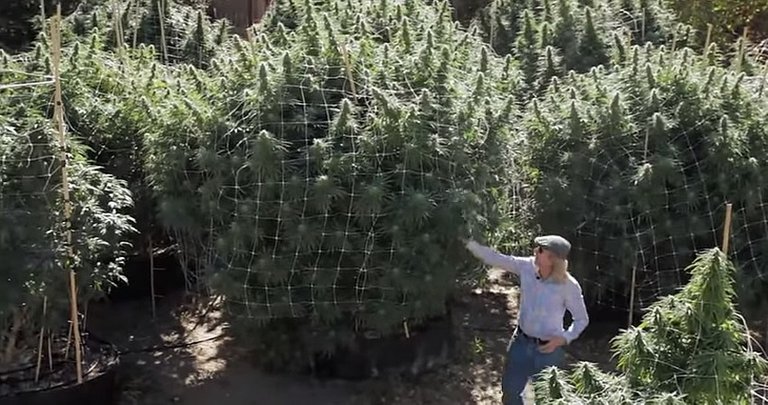
Growing outdoors can save you lots of money when it comes to lighting. Outdoor cannabis plants will use the greatest source of light, the sun, which is free! But, keep in mind when growing outdoors the photo-period tends to be much more gradual so it takes longer for the plants to fully bloom during flowering. One great benefit of growing outdoors is that you do not have to worry about changing your air supply regularly and constantly, as outdoors this occurs naturally with an abundance of fresh air all the time being supplied to your plants.
Now let's talk numbers. If you grow 10 plants indoors with a 400 watt metal halide grow light, each plant will yield about ½ to 1 ounce of marijuana. (Don't worry, we have some tips later that will show you how to increase yield, but for now these are average guidelines.) A single plant grown outdoors will yield about a pound(16 ounces) of marijuana, or sometimes even more! There are also downsides to growing outdoors.
You have no control over light cycles and must grow on the natural annual harvest cycle, you have absolutely no privacy and some areas require you to take privacy precautions in order to grow for medical use. Outdoors you have open ventilation which means your plants could be pollinated by wild pollen messing up your attempts to breed seed of a certain strain or avoid seed. You are also mostly limited to soil grows outdoors unless you have a greenhouse which is sort of a hybrid of indoor and outdoor growing.
So remember that generally outdoors = massive yields, lower quality due to lack of environmental control. Indoors = lower yields, much higher quality.
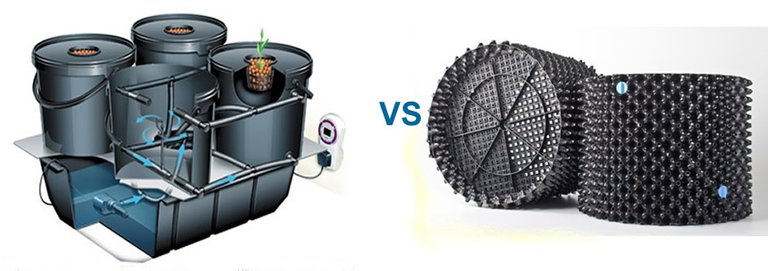
Indoor growers are initially faced with a very important choice. Do they go with a hydroponic system, or soil? On one hand you have soil, the traditional growth medium that has been used for thousands of years to grow plants, and on the other you've got hydroponics, a more recent practice of growing plants with water and nutrients but no soil.
For a first time grower it is popular opinion that the "better", more convenient setup is soil. Hydroponics makes plants grow faster, but when starting out, unless you learn extremely quickly it generally won't make your buds more potent than soil(at first). Hydroponics should be attempted after you have a few successful soil crops under your belt, or if you feel you will be able to jump right in successfully without becoming overwhelmed. If you are starting from seed and growing for personal use, soil is the practical growing medium. If the crop is started with clones and is commercial, a hydroponics setup is then definitely more practical.
It is of popular opinion that soil is far superior in terms of quality factors such as bud taste and flavor. People pay fortunes for the best quality, so soil is ideal for this reason. It is also cheaper on your wallet. Many growers also find that soil is more forgiving. If you make a mistake with hydroponics the damage can be drastic and irreversible.
A hydroponics garden's nutrient and root setup aids in faster plant development, but it takes a lot of monitoring. Hydroponic gardens benefit the overall growth of the plant in terms of size - root systems are spread throughout soil in order to increase surface area and the chance that the plant will absorb minerals and water that permeate through the grow medium.
With hydroponically grown plants, the nutrients are present all throughout the liquid mixture. That way, the root system does not have to be as extensive as with soil-based plants. This means that the plant can devote more nutrients and energy to growth above the root system, which is the kind of growth that leads to potent big buds.
As plants grown in soil begin to grow larger their root systems begin to cramp. They then must be placed in a larger container, or transplanted . Hydroponically grown cannabis does not need to be transplanted. This saves time and increases growing efficiency greatly(hydroponically grown plants do not have to deal with problems such as “transplant shock”).
Hydroponic grow mediums are definitely an improvement over traditional soil when it comes to speed of production and overall yield, but it is much easier to grow marijuana in soil. It is not that difficult to set up and operate a hydroponic system, but one detail like a faulty irrigation timer can cause devastation if not immediately corrected.
The hydroponic solution must be monitored closely and kept balanced, while a well prepared soil solution may not need any additional fertilizers for the entire life of the plant. As long as you water the soil when it gets dry the plant will thrive and be happy.
Soil-grown pot is considered by many to have a more palatable taste than hydroponically grown herb, but there are always exceptions to such rules. Some growers get the best of both worlds by experimenting with organic hydroponics, but most use basic stock solutions that contain fertilizer salts in a readily available form.
These salts are easy to administer in tried-and-true formulas, but the problem is that these stock solutions tend to leave a metallic taste in the precious produce. Experienced growers know to leach their plants before harvest to remove residual salts from the buds, but it appears that few bother to leach sufficiently for a truly clean, pure taste.
A milder feed solution will prevent the build-up of excess fertilizer salts in the bud. Leaching time varies from grower to grower, from two days to two weeks. Some use plain or distilled water, others simply use a very diluted feed solution.
For the newbie grower, soil is definitely a great choice. A Hydroponics setup takes up more room, is less stealthy(along with the noise), plus the care and monitoring of the system, and high costs are often too much for a newbie first starting out. But, as cannabis cultivation gains widespread popularity, easy to use inexpensive all-in-one hydroponic grow systems are available for purchasing.
(For tips on choosing the right hydroponic system for you, please refer to the hydroponic section.)
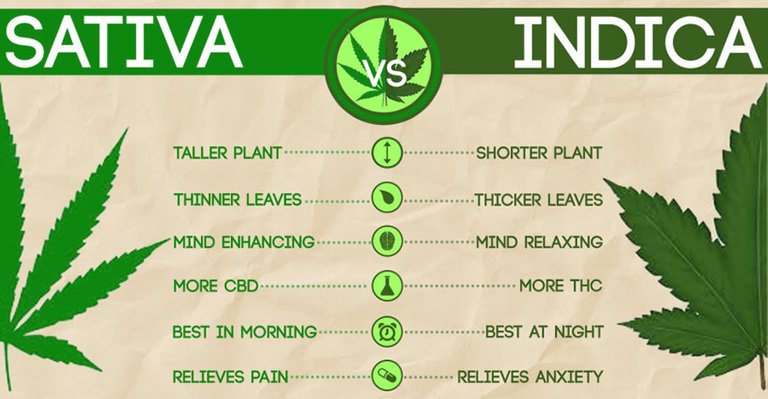
The first step for growing your own buds is to obtain some good marijuana seed strains. This first crucial step to reaping the highest quality and quantity yields is starting off on the right foot with with the best Cannabis strain seeds you can get. Genetics determine the quality of the maturing plants, so what you want to look for are strains with favorable genetics. Potency, aroma, fast growth, early maturation, and resistance to fungus & pests are a good start. The best seeds come from the best plants, and vice versa.
Each variety is either a “pure” species type(taking two plants in the same species and crossing them) or a “crossbreed” of two or more species(taking two plants from different species and crossing them). Examples are Pure Sativa, Sativa (mostly sativa species with indica), Pure Indica, Indica(mostly Indica with some Sativa),and Indica/Sativa Hybrid(this is a 50/50 cross between a Sativa and Indica species).
If you are serious about producing marijuana, don't settle for any available seed you can get, go for the best. (Later I will show you my top recommended reliable seed banks who offer quality seed strains at low prices with stealth discrete shipping near the end of this section, so slow your wheels Turbo.)
So first things first, what exactly does the term “strain” mean? Well, a marijuana strain is simply what sets the marijuana apart. It offers unique characteristics. Veteran growers can recognize these specific on-the-market strains just by mere observation. Most strains of marijuana are derived from two species of cannabis, they are Cannabis Indica and Cannabis Sativa. Both species have very unique characteristics that affect the user differently. If you are a complete beginner than we highly suggest you start your first batch off with Indica in order to learn how to grow properly. As you gain more experience you can craft an Indica/Sativa “hybrid” mix, and then eventually a complete Sativa strain.
An Indica/Sativa mix will yield a larger crop that is not as tall as a pure Sativa, but THC level will be lower and CBD levels will be higher. If you are growing indoors this Inidca/Sativa hybrid is strongly recommended due to it having the best high and best indoor growth characteristics. Sativas are hard to grow indoors due to specific height requirements and late flowering tendencies, so a hybrid can be bred that will have the energetic cerebral high of the Sativa and the early maturation & “easy-to-grow” characteristics of the Indica plant.
Cannabis Indica

Physical Characteristics:
Height – Squat and dense with heavy, compact buds. Nodes – Has long internodes between branches, averaging 3-6 inches. Leaf – Broad pointy leaves with no markings or patterns, rounded on the sides. Indica leaves are wide with short fingers.
Indica's originally come from the hash producing countries of the world like Afghanistan, Tibet, and Morocco. They are short dense plants, with broad leaves and often grow a darker green. After flowering starts they will be mature in 6 to 8 weeks. The buds will be thick and dense, with flavors and aromas ranging from pungent skunk to sweet and fruity.
Indica has higher CBD and lower THC levels than Sativa. In laymens terms this means marijuana from a pure Cannabis Indica strain will produce a heavy, stony, tiresome sleepy type of stone in the user. As far as the yield of Cannabis Indica plants goes, it is usually higher than Cannabis Sativa plants, and they take a little bit less time to mature.
Indica buds tend to be smelly - they smell like a pungent bad body odor. Their smoke is thick, even a small toke will often induce fits of coughing! A Pure Indica high has the properties of a body stone / couch potato feel. The smoke from an Indica is generally a body type stone, relaxing and laid back. The best Indicas have a relaxing social high, which allows the person to sense and feel the environment, but does not lead to thinking or over-analyzing the experience. Poor quality Indica marijuana and hashish contain high quantities of CBD. This is where the toker becomes lead- headed and sleepy.
Note: For desirable medical marijuana you should grow a plant low in THC and rich in CBD. Let the plant vegetate for a longer period of time and harvest when all pistils have attained their color, i.e. as late as possible. More on this later. Cannabis Indica strains are easier to grow and don't get as tall as Cannabis Sativa strains, but they tend to be bushier and have to be grown further apart.
They tend to be thick and strong, they can take more cold than the sativa - overall they are just a tougher plant. This is why the Indica strain is best for newbies and when growing in an area where height is a consideration, like a small closet or cabinet.(If you have your heart set on growing sativa as a beginner, then we recommend a Northern Lights cross, as this is a very easy to grow Sativa strain indoors).
So the great thing about growing an Indica strain is that it produces a higher yield, is much easier to grow, it's shorter in height, and it grows and matures faster. At maturity, the leaves start to turn a dark purple. It has short branches laden with thick, dense buds, which mature early. Indica plants tend to be short, bushy, mature early, have more chlorophyll and less accessory pigments (accessory pigments protect the plant from excessive sunlight). As Indica strains have more chlorophyll than Sativa they grow and mature faster.
The only downside is that Indica tends to be less potent, and usually doesn't taste as good. Under artificial light an Indica plant will mature faster than a Sativa. Approximately four weeks of extra light is required to bring a Sativa plant to maturity, and even then its' weight is often much lower. Therefore, Indica tends to be a favorite among industrial weed farmers. More Indica strains are grown for sales-specific goals, making the dealer/grower richer.
Cannabis Sativa
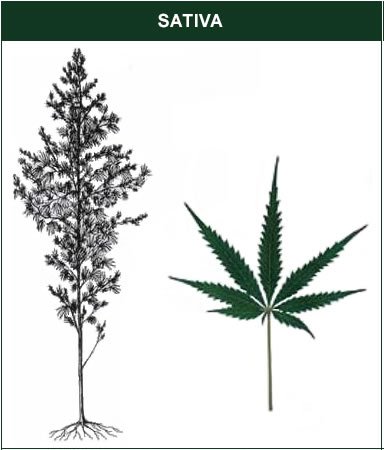
Physical Characteristics:
Height – Tall and hardy with fluffy buds. Nodes – Has short internodes between branches, averaging 3 inches or less. Leaf – Narrow finger-like rounded leaves with marble-like patterns. Slender, with long fingers.
Sativa has higher THC content and lower CBD levels than Indica. This means that marijuana from a pure Sativa strain produces a more cognitive(in the brain), “floating” type of high that tends to be more energetic when compared with pure Indica. Sativa buds smell sweet, fruity and perfumed, and their smoke is usually smooth and easily inhaled. Once flowering has begun, they can take anywhere from 10 to 16 weeks to fully mature. Flavors range from earthy to sweet and fruity.
They grow very quickly and can reach heights of 20 feet in a single season. They originally come from Colombia, Mexico, Thailand and Southeast Asia. The buds are long and thin(makes for much fluffier lighter bud), far less densely populated than the Indica, although longer in length(sometimes stretching 3ft. in or more along the branch). The stomas of the flowering bud may be tinged slightly purple in a cool climate but in a warmer environment will turn dark orange or even red. Maturation time varies considerably.
Sativa plants are taller, take longer to mature, have less chlorophyll and more accessory pigments(accessory pigments protect the plant from excessive sunlight). As Sativa strains have less chlorophyll than Indica and they take
longer to grow, mature, and require more light. Sativas have a huge root system. They are much more drought tolerant than the Indica plant. The yield generally tends to be lower than indica, but the plants are way more potent. The Sativa plants tend to also grow taller, and take longer to mature... so they are best suited for outdoor growing.
But don't worry, there are certain strains you can get specifically designed for growing indoors.
The good thing about growing Cannabis Sativa buds is that they are more potent and taste really really good. Typically, pure sativas have a high THC/CBD ratio (that is to say, not much CBD), and so they tend to provide clear, buzzy, “up” highs. When smoking a sativa the high is very Cerebral, you have a rush of energy, a buzz in the body and a great way of getting the housework done without vegging out on the couch. On the other hand, pure indicas tend to have much more CBD present. Commercial hash is usually manufactured using the resin of Indicas, explaining its stony, drowsy high.
The downside? Lower yield, takes longer to mature, and generally harder to grow.
Note: If your seed has a ratio such as 40% Sativa, 60% Indica then you can imagine what the high will be like. It has 40% of the “head high”, and 60% of the “body stone”.
So remember, Indica plants have a heavy, stony high that is relaxing and can help different medical problems.
Sativa plants have an energetic, cerebral high which can stimulate brain activity and may produce hallucinations.
Hybrid strains have a combination of both Indica and Sativa highs which are relative to strain ratio. The leaves of a hybrid tend to be thinner than an Indica, but much broader than a Sativa. Once you get good it is possible to recognize a good hybrid solely by the leaves once you know what to look for.
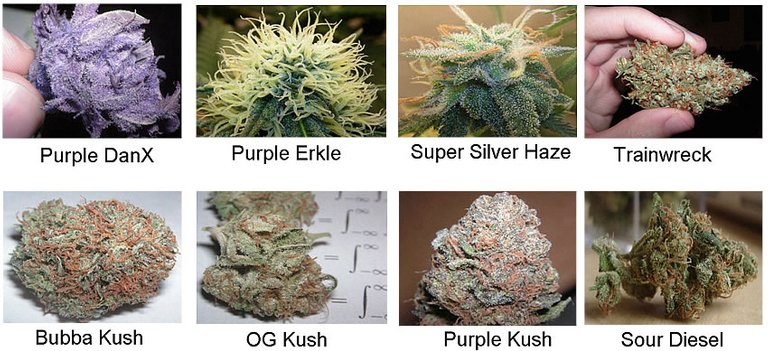
Choosing your cannabis variety is extremely important. It really depends on your growing goals. There are several key factors to consider when deciding what varieties of cannabis you want to grow - the type of high, the maturation time, and the shape of the plant all are very important. Once you have chosen your quality seed-bank supplier and have a good idea of what type of plant you want to grow, it is now time to choose your seeds wisely.
Many newer growers make the mistake of choosing cannabis varieties that favor a high potency thinking this is what they want. The quality of high is just as, if not more of an important selection factor.
Note: Be sure to choose the BEST possible seed you can get your hands on because later you can produce your own seeds and clones from that strain!
Make sure your seed strains have good genetics. This is CRUCIAL. Bad genetics can lead to mutations, warping, flowering problems, poor germination success rates, ad nauseum. Sometimes even problematic nutrient symptoms will appear even though your nutrients are fine and you know for a fact a nutrient problem does not exist. It is very important to find a reputable supplier for top-shelf quality strains that are bred with great genetics.
If you are a first time medicinal grower I would recommend Big Bud, Top 44, Northern Lights, or Skunk #1. All of these are great – they are the easiest, most durable, with great yields.
Another very important factor to take into consideration when choosing a cannabis variety is the plant's yield. Some plants will bud heavily and produce very very thick top colas and others simply wont. A heavy-yielding plant can be worth easily twice as much as a lesser-yielding one. (Remember Indica varieties are great for commercial growing as they produce heavy yields and mature early.)
If you're commercially growing, in general the type of high does not seem to be an important marketing factor at all. The yield, taste, aroma, and the overall bud appearance are important in determining the final price amount.
For some, the type of high may be more important to them than their yield amount, and that's OK and very common. Note: Feminized seeds produce a higher % of female seeds, but 100% female is never guaranteed So again, it all really depends on your individual goals as a grower...
Don't feel frustrated when at first trying to decide. Because there is large selection of strains in the internet, this can sometimes get overwhelming when trying to decide which one to order. Choosing is not as difficult as you may think. There are really only two sides of the marijuana family - Indica's and Sativa's.
Combining different Indicas, different Sativas or a combination thereof creates hybrids. The resulting hybrid strains will grow, mature and smoke in relationship to the Indica/Sativa percentages they end up containing.
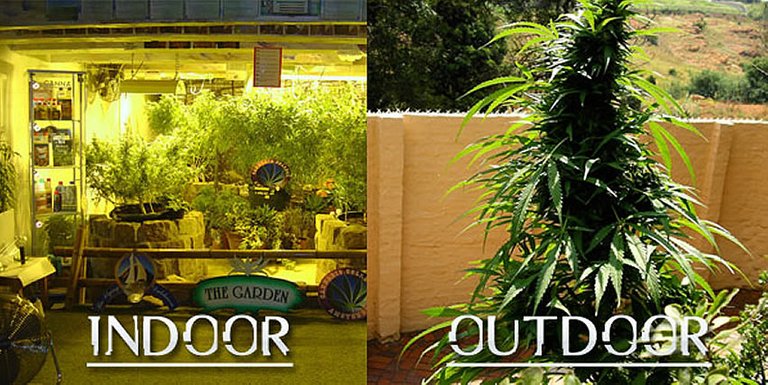
The next thing to check for is if they are meant for indoor or outdoor growing. A lot of new growers argue saying you can use indoor-bred seeds outdoors and vice versa but they will find that trying the opposite does not produce satisfactory results. Outdoor growers want plants that mature early before the arrival of frost, thieves, or pests. Indoor growers generally are looking for compact plants that ripen quickly and uniformly(so that light and space are used in the most efficient predictable manner possible).
So for outdoor marijuana cultivation choose among outdoor intended cannabis seeds strains. Modern marijuana seeds varieties are bred with high level of specialization, take advantage of that and use an outdoor genetics of marijuana seeds for best acclimatization, pest resistance and high natural sunlight absorption.
Whether or not a strain can be grown outdoors also depends on the length of season you have. Take note of listed approximate flowering time. This is most important feature to consider and is completely influenced by the Indica/Sativa ratio. Typically you will want plants that will mature before the danger of frost or bad weather comes along. The more Sativa that is in the mix, the longer it takes to finish up. If you have a very long growing season, most strains can be grown outdoors.
These flowering periods are approximate and will vary depending on conditions. From this foundational starting point you can then go back to what you like and the descriptions of the plants. Plan to grow indoors? Pick a good seedbank and you can browse through a broad range of indoor cannabis seeds strains. Since modern marijuana seeds varieties are bred with high level of specialization, you can get a customized indoor marijuana strain that has genetics favoring shorter plants, higher yields, and quicker growing & flowering.
Height
When growing cannabis indoors, you have complete control over how tall your plants get. You control this by how long you grow them before initiating flowering. Artificial lights do not efficiently penetrate more than 3 feet down into the garden, so it makes little sense to grow them any bigger than that.
After the light schedule is changed to 12 hours on and 12 hours off, flowering will begin in about 7 to 14 days. During this time the plants will continue to grow another 6 to 14 inches and then stop. How much they will grow depends on the Indica-Sativa ratio of the strain. Sativas will stretch the most. Depending on this ratio, flowering should be initiated at around 18 to 24 inches to achieve the end height of 36 inches. How long it will take to get this tall depends on the strain and the conditions in the garden.

Nearly all of the strains available today are pretty potent. The success of the eventual potency outcome will depend on your personal tastes and the conditions in which they are grown. Most seed-banks do not test the THC percentages of strains and no one is really sure what the numbers mean when they do.

Yield is primarily determined by the conditions in which the cannabis is grown. But in regards to end yield amount genetics does come into play. All of the yields listed in your seedbank for the strains are approximate and depends a lot on how they are grown and the quality of the environment. Think of it like an average. You can probably get more. (I'm confident you will if you follow the powerful techniques correctly inside this eBook!) Indoor lights don't penetrate down very far so it is better to grow a larger number of smaller plants to achieve the highest yield of top quality bud. Maximum yields indoors are primarily coming from Indicas and mostly Indica hybrids - the more Sativa in the mix, the lower the yields tend to be.
Typically, your indoor yield is really limited only by the amount of light you have, not the strain you choose. It is up to you as a grower to maximize your plant's potential inside your grow space. Experiment to find out how each strain will respond best.
Flowering times are an indication of how long it will take the plant to mature indoor after flowering has been induced by changing the lights to a 12/12 on off light cycle. This will also be affected by the environment to a certain degree, but is pretty much fixed in the plant.
Indica's are faster flowering than Sativas and hybrids are in relationship to the percentage of each they contain. Sativa's grow very quickly and if you wait too long to flower them they will outgrow the limits of the space and will not fill out. On the other hand, if an Indica is not grown for long enough, the yield can be greatly reduced.
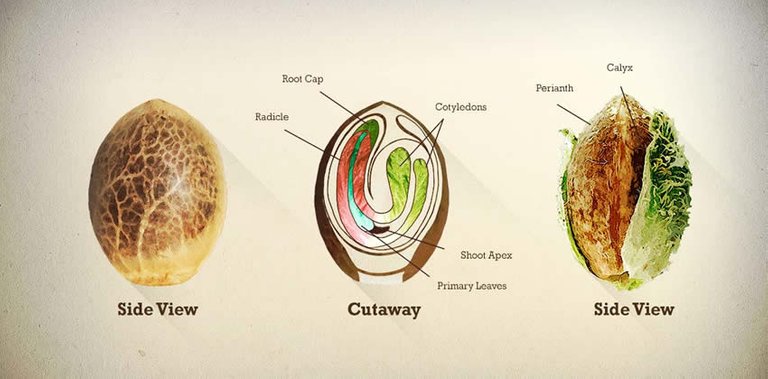
Seeds are the result of sexual propagation of marijuana plants. They contain the genes of both the male and female parent plants. Some plants known as hermaphrodites, produce both male and female flower's on the same plant. The genetics code contained within the tiny seed will determine the plant's size, pest resistance, root stem leaf and flower production, cannabinoid level and many other vital factors. Strong seeds produce healthy plants, and heavy harvest. And you can only get strong seeds from a strong healthy parent.
Selecting Viable Seeds
One of The most important decisions a grower makes when growing marijuana is choosing a starting Grade-A Quality seed. Seeds vary in size and coloring according to their individual cannabis variety. Bunk seeds = dirt weed. A good seed will not be cracked or deformed. The seed should not be green - a green seed is not fully mature. When selecting your seeds make sure they are not shiny, or excessively dark. These seeds will most likely not germinate. You want your seeds to be hard and dark.
Indica seeds tend to be larger than Sativa seeds. Indica seeds often have what appears to be “zebra” stripes. This helps you determine the origin and strain of the seeds. For example, if a seed vendor says a particular seed will grow out as Sativa, but the seed is very large, you can bet that the seed is an Indica and that the vendor isn't giving you accurate information. Growers select seeds that are plump, oily and healthy-looking. Whitish, light tan, weak, pale, green immature or cracked seeds are usually not viable. A seeds viability is determined by pressing it against your fingers or against a hard surface. Bad seeds will crumble. Mature seeds that are hard, beige, dark brown and spotted or mottled have the highest germination rate. Soft, pale, or green seeds are usually immature and should be avoided. Keep in mind seed color and pattern are also affected naturally by the need for camouflage.
WARNING: It is very important you choose seeds from plants that are suited to the growing conditions in your garden. You do not want to buy a plant that will grows 10 ft tall when growing inside a cabinet! Following these proper guidelines you can ensure a successful, potent, satisfying grow. Weak permeable seeds can allow disease and pests to move in. Stay away from soft, pale, immature, white, fragile seeds that crush easily in between your finger and thumb.Look for mature seeds that are strong, hard, & beige to a dark-brown. If it's spotted or mottled you can bet it has the highest germination rate.
Selecting The Correct Genetics
Since humans have been cultivating cannabis for thousands of years, virtually hundreds of varieties are available to the modern day grower. There are many commercial seed-banks that sell an assortment of award winning time-tested strains. Be sure to select a plant that will survive in the climate it is to be grown in. For example, a plant native to Jamaica, where the growing season is longer, will not be able to complete flowering in Canada. Know the date of the first expected frost and choose a variety that will be ready for harvest before then. If you are growing commercially then the yield per plant is also important. Different varieties have different yields. The biggest yielding plants are grown near the equator where the sun is much more intense and the growing season is longer. If these plants are chosen they may have to be finished in a greenhouse in the northern US and Canada.
Where can I Get Seeds?
Buying seeds is tricky. If you can't find a friend willing to hook you up with some quality seeds then your next best bet is grabbing your seeds online. There are a lot of sketchy companies out there nowadays. We've heard countless horror stories about online seed-bank companies where lots people have payed top dollar for their seeds and never received them. Then the company mysteriously disappeared, with a disconnected phone line and complete with a missing website. What a way to blow $200! You need to be extremely careful when buying seeds nowadays. Do not risk it - get them only from a reputable company on the internet, from magazines, or any local coffee shops around your town(if available). Stick with a reputable reliable company. You may wish to buy more than you think you will need due to germination failures.
Note: Marijuana seeds are still illegal in many parts of the world, including the United States. Please check local laws before ordering and always use a safe address. Never order the marijuana seeds directly to your grow area.
Please be careful! Over the years, I have tried various companies and after speaking with hundreds of growers as well as investing in countless of hours of personal research and money to seek them out & test them; I have determined the following list to be the current best seed banks in the world. If you are going to purchase your seeds from a different vendor, please be safe - google them first in order to make sure they are reliable and no one has been ripped off in the past, as this happens a lot. Make sure they are reputable and carry the most important foundational aspect of your entire grow – a quality seed.
As promised, here is my highly recommended list of seed banks with reviews. The following list of seed banks are the most reliable today with the greatest quality and outstanding selection. They take every precaution to ensure that your package is delivered in a stealthy, timely, secure manner. These vendors have been in the seed business for many years and have successfully shipped countless packages to many satisfied customers worldwide. You can find them recommended on many review sites. Discreet packaging and efficient customer service guarantees these companies will continue to thrive for many years to come.
Storing Seeds
Typically, marijuana seeds produced by a female plant will be good for about two years. If kept in a cool, dark place(the ideal storing location) the seeds may be good for even up to 5 years!
Many growers favor storing seeds in a cold environment for optimal germination rates. Since a seed is a living thing, when it is placed in a cold environment its life cycle slows down. This slows the seeds natural degradation significantly, meaning seeds stored in cold environments last longer. The favored seed storing method among many commercial growers is to get a black film canister(blocks out the light) and place a small amount of either uncooked rice or loose/bagged silica crystals in the bottom. These desiccants soak up any surrounding moisture and humidity. Put them in either your fridge or freezer.
Note: You can also use specifically designed seed envelopes sold at most grow shops or online. Make sure to label the container/envelopes with strain, quantity and date received to make sorting easier. Remember when storing seeds that incorrect moisture(humidity), temperature, and light levels are the number one enemies.
Many growers agree - temperature and humidity are the most important factors affecting seed quality during storage(humidity being the more important of these). Marijuana seeds absorb moisture from wet atmospheres and dry out when placed in dry atmospheres. Seed storage life is doubled for each 1% decrease in moisture content. The problems of maintaining seed germination increase with seed moisture content.
Seed moisture above:
- 40-60% - germination occurs.
- 18-20% - heating may occur.
- 12-14% - fungi grown on and in seed.
- 8-9% - insects become active and reproduce.
Heating is caused by the natural respiration of cannabis seeds, of fungi and bacteria in and on the seed which may build up rapidly in a moist environment. High moisture levels and high temperature will kill cannabis seeds as quickly as and invasion of microorganisms and insects. Stored seed life is doubled for each 41°F(5°C) reduction in storage environment temperature.
Refrigeration to at least 41°F(5°C) is recommended(yes, this is slightly warmer than regular fridges). The cooler the temperature the more slowly seed vitality declines. This rule apparently continues to apply even at temperatures below freezing. At 41°F(5°C) and below, insects become inactive. Ever see someone freeze a fly and then blow warm air on it to heat it up(“revive” it) and then it flies away? A pretty cool magic trick if ya' ask me. If the above storing conditions are met, storing cannabis for five years with high germination success rates is entirely do-able.
My Related Posts
- Diy Grow Fridge Tutorial
- The Art Of Potsai, An illustrated guide to growing miniature marijuana plants
Marijanes's Diary #2 Sexing, Methods to Determine Sex, Stages of Growth, Vegetative Growth, Pre-Flowering and FloweringPlease be sure to follow me @bitminter for
Piece
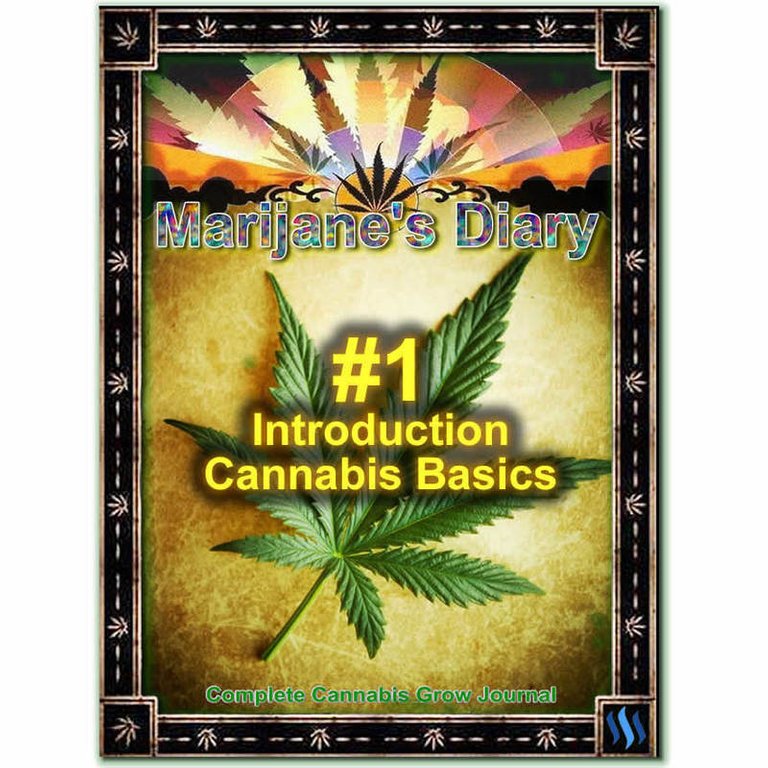
Wow you know a lot about cannabis. Thanks for the info.
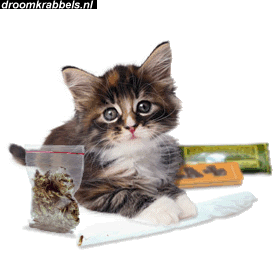
I em bipolar-borderliner and have cronical back pain .
Now you done it, probably took you 2 days to write it. You get my up-vote at 30min mark even tho i haven't finished reading, bookmarked post as might come in use someday. :)
Lol I have been at it for 8 hours now! Thanks much appreciated!
Hardly an introduction to Cannabis, I now have a PHD
Thanks, did my best.
I used Anchors tags in the index using html but unfortunately steemit is not interpreting it. A pity because it would have made life easier as its a lot of info. Possibly it will work in the future :-)
Wow, I applaud your incredible blog. Where did you get your knowledge and how long did it take? Reason I ask is my son loves botany, but not doing to well with his hydroponics (herbs) experiment.
@magnebit My best advice is for him to first master growing in soil. Soil is much more forgiving as the soil acts as a natural buffer with regards to ph. I will update you once I have posted more in detail on growing. Thanks
Wow, very informative. I'm sending a few people this way!
Thank you I appreciate it! More coming soon!